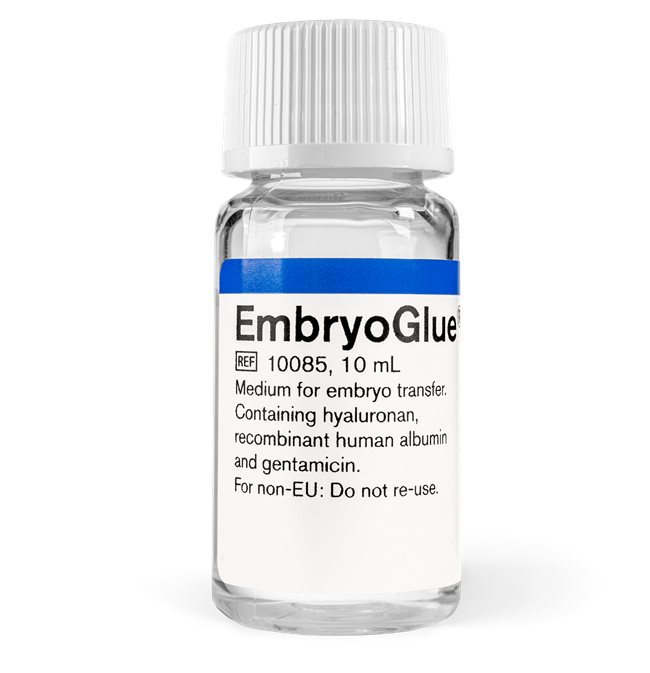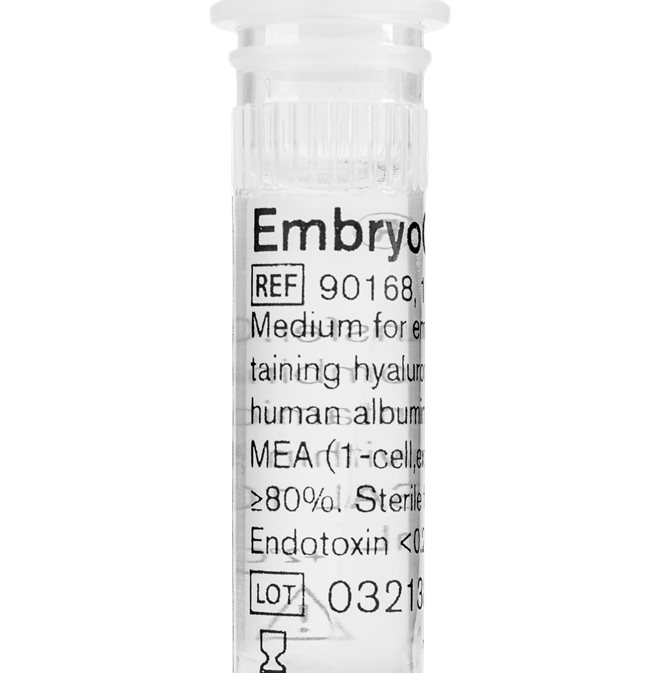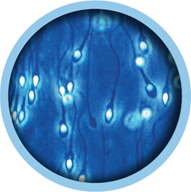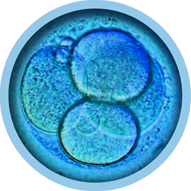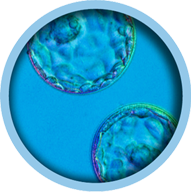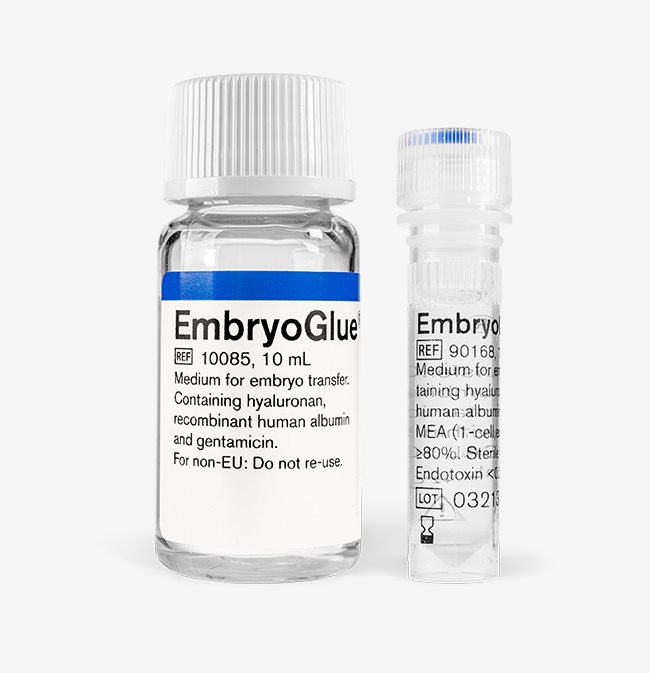
EmbryoGlue®
Proven to increase clinical pregnancy rate and live birth rate when used for embryo transfer1
Description Bicarbonate buffered medium containing hyaluronan and recombinant human albumin.
Purpose Medium for embryo transfer.
Application For use after pre-equilibration at +37ºC and 6 % CO2.
Storage Store dark at +2 to +8°C
EmbryoGlue for successful transfer
Embryo transfer is one of the most sensitive and critical procedures in IVF treatment. EmbryoGlue®, a hyaluronan-rich transfer medium, is designed to promote embryo implantation. Few interventions in embryo transfer have improved the success rate as significantly as EmbryoGlue according to the clinical evidence2. EmbryoGlue has been shown to promote successful implantation and increase the pregnancy and live birth rate without increasing the risk of adverse events1.

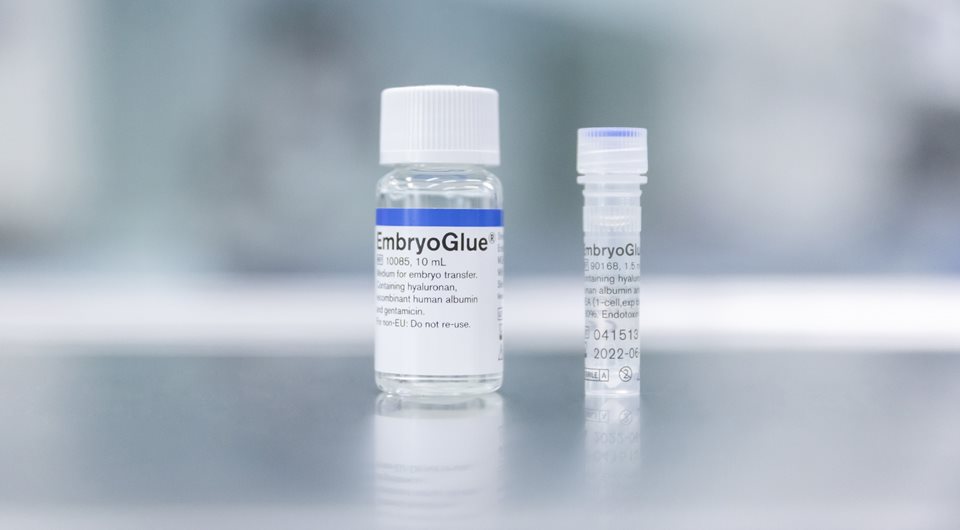
What is EmbryoGlue?
EmbryoGlue is a medium developed exclusively for embryo transfer and is the only existing transfer medium with a proven implantationenhancing effect1. EmbryoGlue has the basic composition of a rich blastocyst culture medium and contains recombinant albumin and a high concentration of hyaluronan. It can be used for transfer of all embryo developmental stages, including cleavage embryos, blastocysts after assisted hatching, biopsied embryos and cryopreservation. The use of EmbryoGlue for embryo transfer can increase the clinical pregnancy rate and live birth rate1.
The proven effectiveness of EmbryoGlue
- How successful is EmbryoGlue?
Since the market introduction of EmbryoGlue in 2003, multiple studies have been published regarding its effectiveness.
Three reviews on the effect of hyaluronan in transfer media have been published by the Cochrane Library in 2010, 2014, and 2020.
The Cochrane Review in 2020 on “Hyaluronic acid in embryo transfer media for assisted reproductive technologies” by Heymann et al. concludes:
"Moderate‐quality evidence shows improved clinical pregnancy and live birth rates with the addition of hyaluronic acid as an adherence compound in embryo transfer media in ART"
The miscarriage rate was reduced in some studies but did not reach statistical significance in the total data set. The review includes a total of 26 randomized, prospective, controlled trials including a total of 6704 patients undergoing IVF/ICSI treatment. The embryo transfers were performed in either a transfer medium containing no or a low concentration of hyaluronan or EmbryoGlue with a high concentration of hyaluronan.
What is the clinical outcome of using EmbryoGlue?
The live birth rate increased from 33.3% to 40.2% with the use of EmbryoGlue. According to a number needed to treat (NNT) calculation, based on the Cochrane Review, one additional live birth was achieved for every 14 transfers. For a clinic with 700 cycles annually, this is one additional baby born per week, or a 20% increase in live births1.
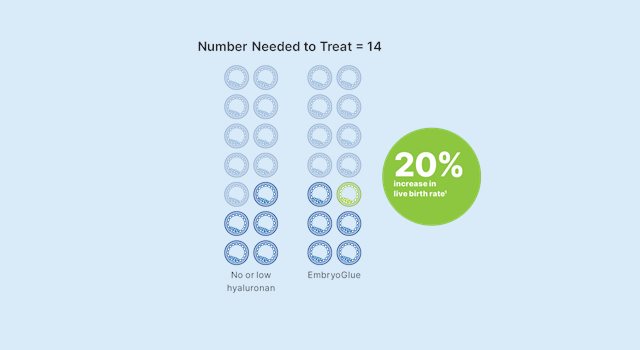
The number needed to treat varies between patient groups, and the strongest benefit is seen in women ≥35 years of age and women with Previous Implantation Failures (PIF)3.
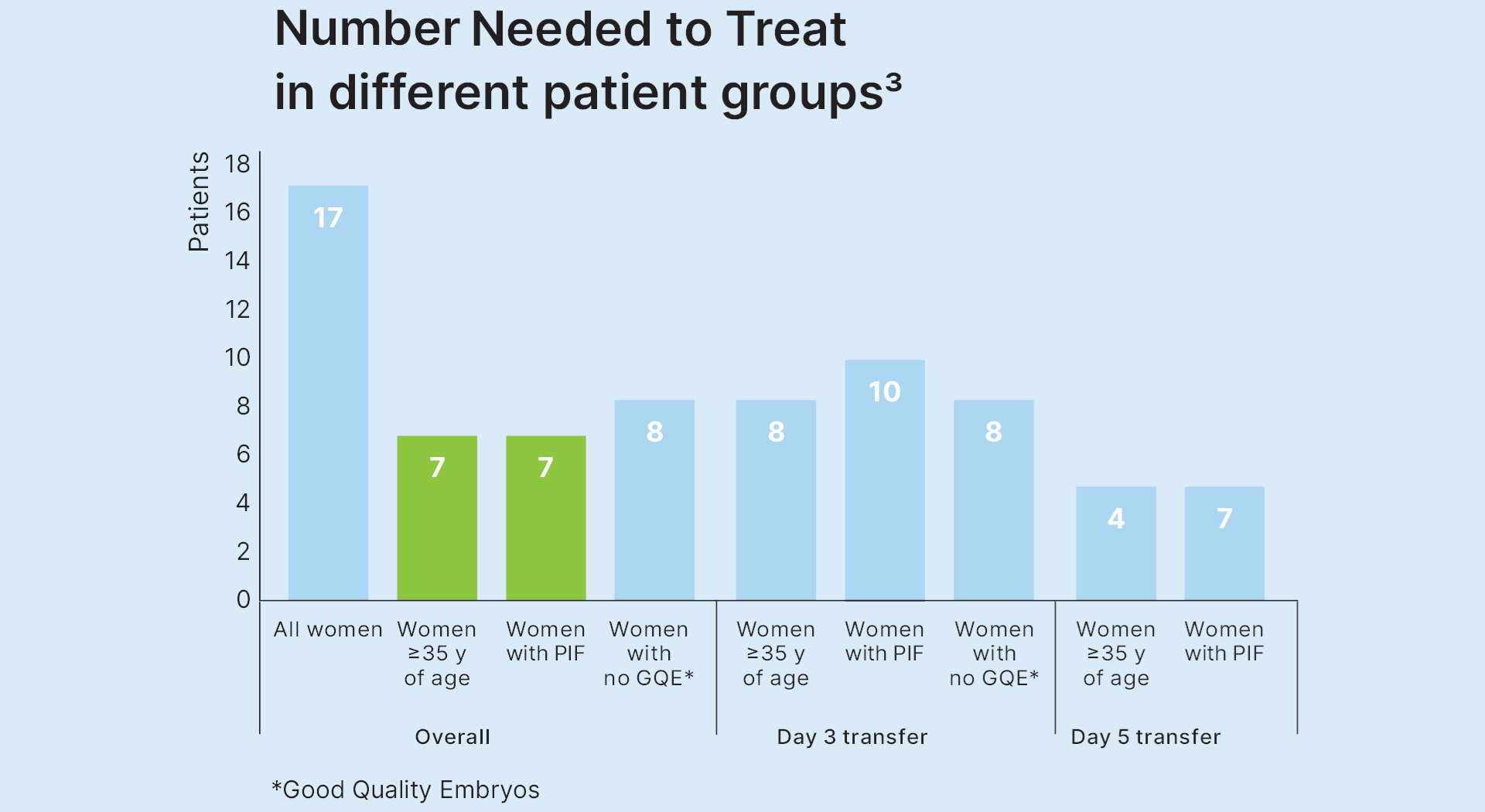
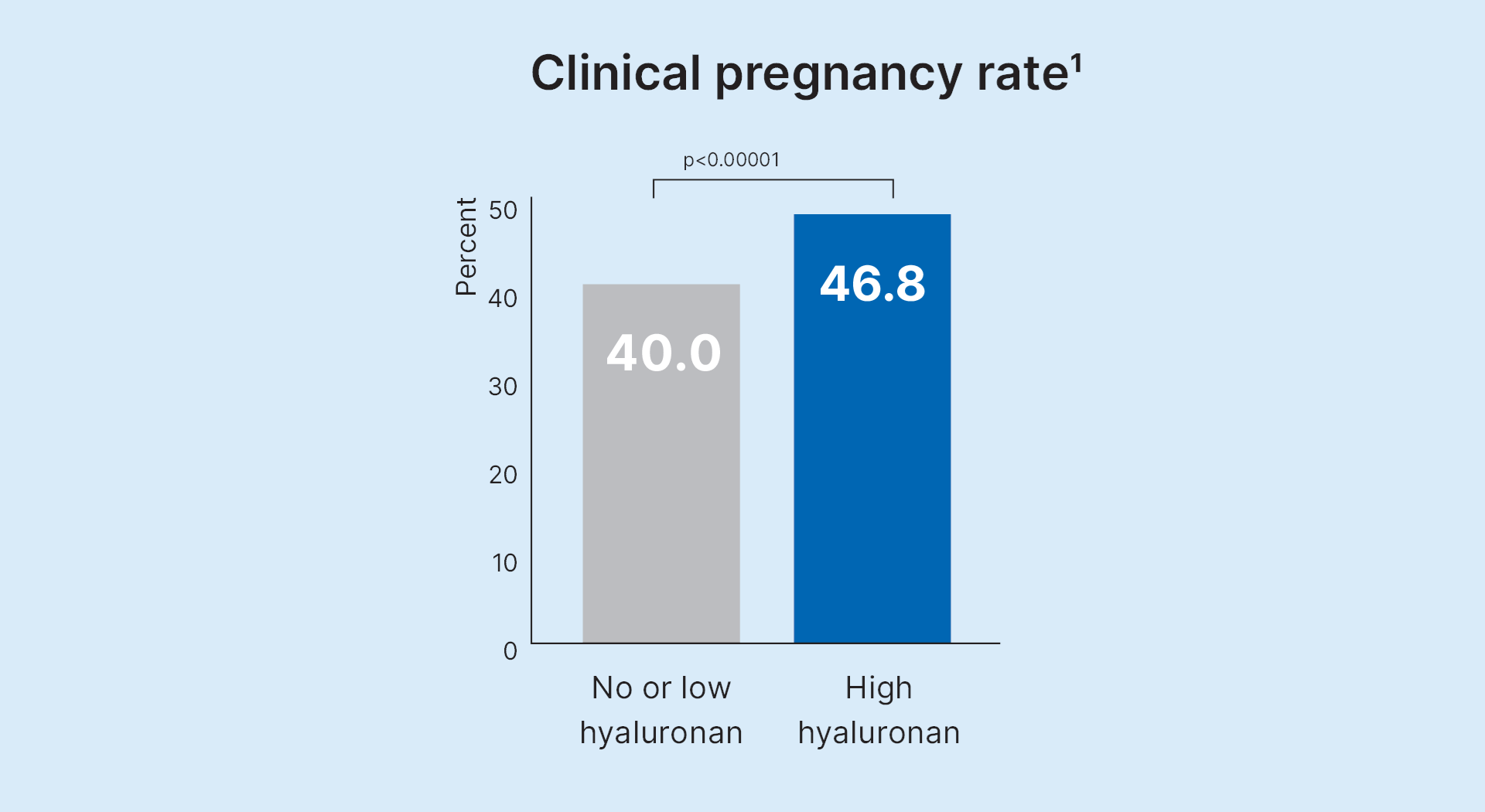
EmbryoGlue recommended ”add-on” by ESHRE
In 2023 Lundin et al. published a study on good practice recommendations on add-ons in in reproductive medicine26.
”Hyaluronic acid addition to transfer media is recommended. Monitoring of the multiple pregnancy rate is still advisable”.
A recommended ”add-on” is defined as a test/intervention that can be applied to most patients or to those patient groups for whom it may be of relevance. The recommendation can be adopted as a policy in most situations.
Read the study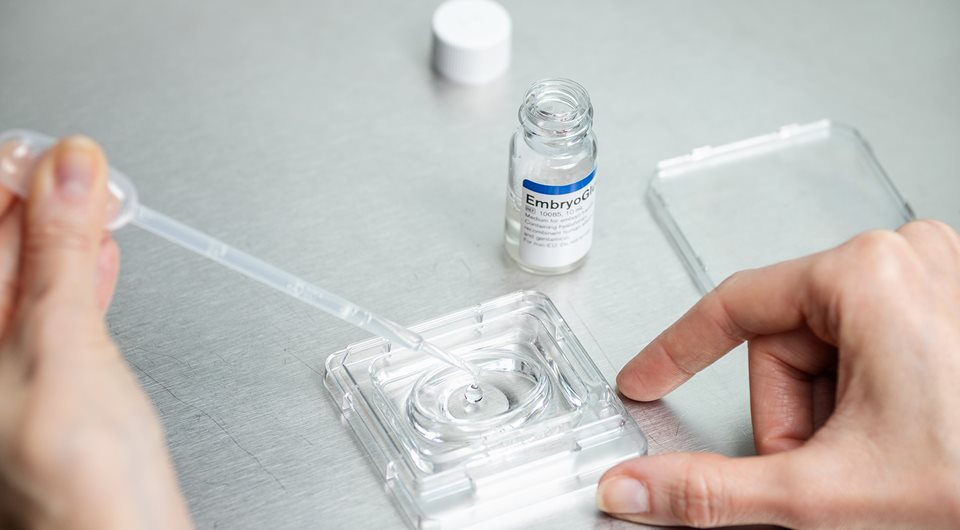
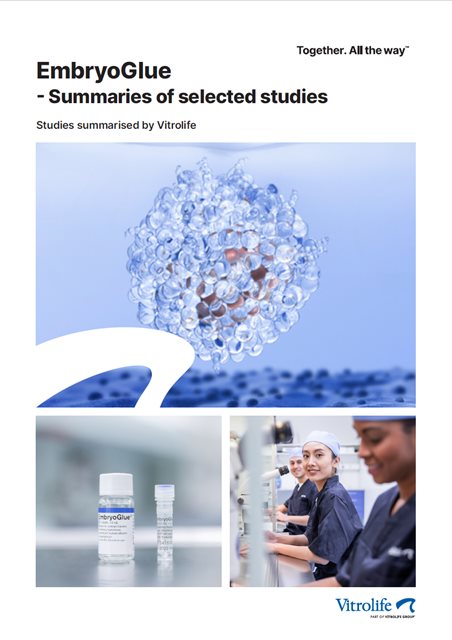
EmbryoGlue – Summaries of selected studies
The effectiveness of EmbryoGlue has been proven in many clinical studies, performed 2002-2022. In this document we have gathered and summarised the strongest clinical evidence of EmbryoGlue which demonstrate its effect and safety.
Download PDFHow does EmbryoGlue work?
EmbryoGlue is a transfer medium containing a high concentration of an implantationpromoting macromolecule, hyaluronan.
Hylauronan is the main glycosaminoglycan present in follicular, oviductal, and uterine fluids and can significantly contribute to the high-viscosity environment of the female reproductive tract4,5,6,7.
The synthesis of hyaluronan increases dramatically on the day upon which implantation is initiated, and it decreases to near basal levels by the next day, indicating its importance for the implantation event. Other types of glycosaminoglycans do not show elevated synthesis at the time of implantation8,9.

EmbryoGlue is as safe as standard of care
When using an implantation-promoting medium, one may be concerned that embryos without the potential to become a healthy baby may implant; however, no increase in adverse events, such as early or late miscarriage, has been shown1,17,18. Due to the increase in implantation with EmbryoGlue, it is recommended to be used with a single embryo transfer policy1,17.
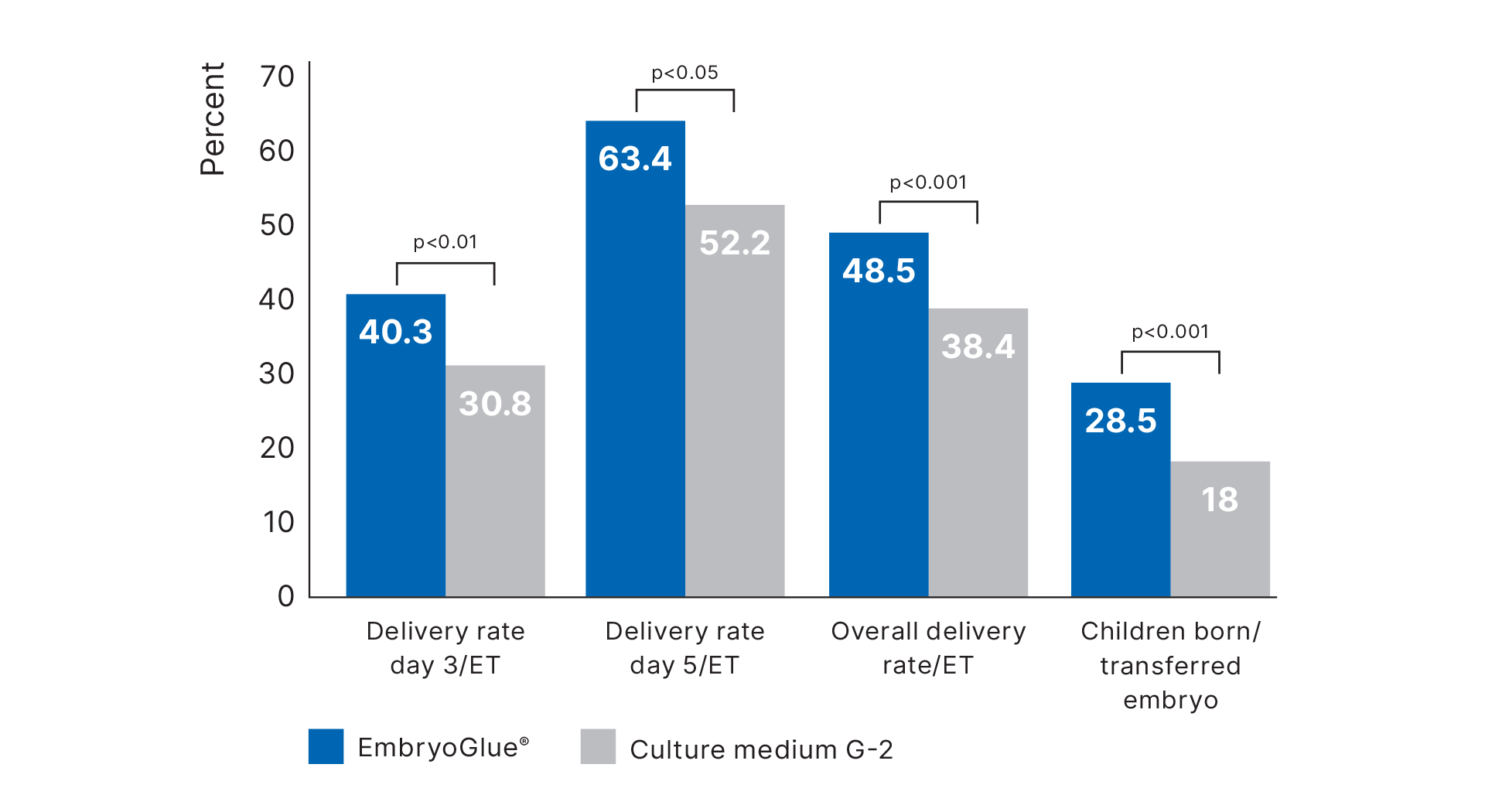
Increased live birth rate in all development stages
In 2011 Balaban et al. performed a follow up study on pregnancies obtained by Urman et al. (2008), with the use of EmbryoGlue. The study included almost 1300 embryo transfers.
The results showed a significantly increased delivery rate with the use of EmbryoGlue independent of day of transfer3,19.
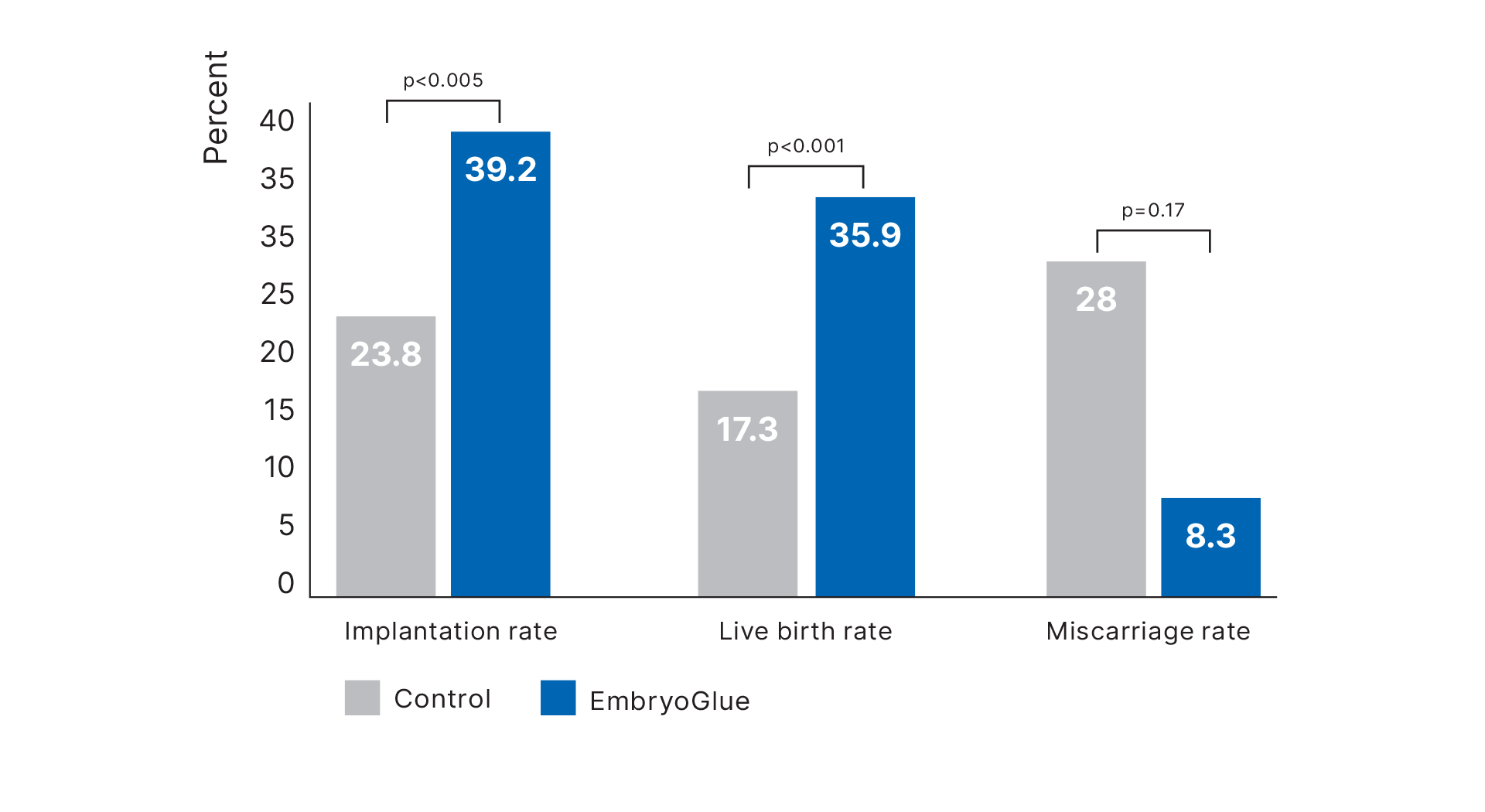
Outcomes of PCOS patients after fresh SET in EmbryoGlue
According to Kandari et al. (2019), the use of EmbryoGlue for time-lapse SET in women with PCOS significantly increases the implantation rate and live birth rate with lower miscarriage rates compared with conventional embryo transfer medium18.
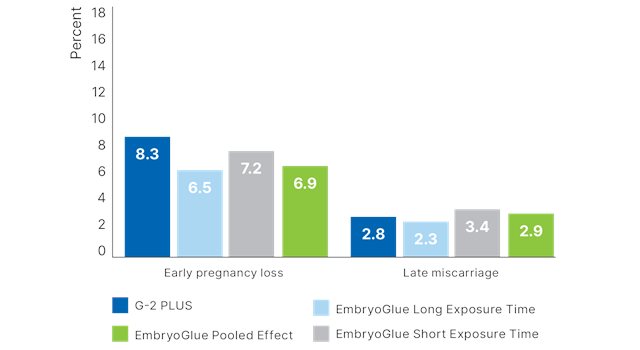
No increase in pregnancy loss
Adeniyi et al. (2021) investigated a total of 3391 fresh embryo transfers in a study between 2011 and 2015 using three different protocols – low hyaluronic acid (G-2 PLUS), short (10-30 min) EmbryoGlue exposure, and long (2-4h) EmbryoGlue exposure. The purpose of the study was to assess the safety and efficacy of implementing EmbryoGlue as a transfer medium. The results showed no increase in pregnancy loss or miscarriage and an overall improvement in live birth events17.
PGT patients and EmbryoGlue - a perfect match
PGT (Preimplantation genetic testing) treatment requires a lot of time, effort, and resources in your clinic. The increased complexity is estimated to add six hours of working time for every cycle that includes genetic testing, which is the reason why you want to give your embryos the best chance of implantation.
Data indicates that PGT embryos benefits from being transferred in EmbryoGlue. A retrospective study showed the clinical outcomes from 830 transferred embryos (557 in the control group with no hyaluronan added and 273 transferred with EmbryoGlue). The data showed an increase in both implantation rate and clinical pregnancy rate20.
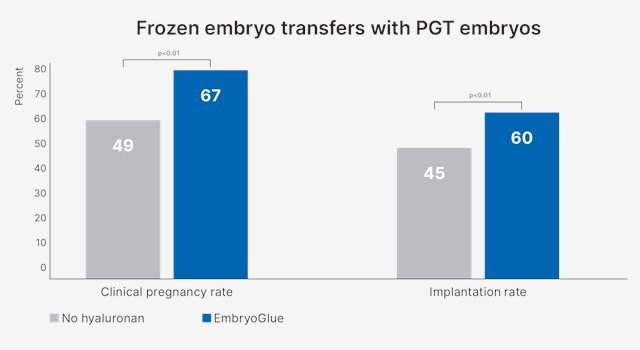
Patient groups offered
PGT21,22
- Older patients >35
- Patients with previous implantation failure
- Blastocyst transfer
- Patients with recurrent miscarriage
Patients groups benefiting most from EmbryoGlue3,23,24
- Older patients >35
- Patients with previous implantation failure
- Blastocyst transfer
- Transfer of cryopreserved embryos/ blastocysts
The reintroduction of EmbryoGlue as the embryo transfer medium unexpectedly coincided with statistically significant improvements in clinical outcome metrics – chemical, clinical, and ongoing pregnancy - specifically for frozen embryo transfers in PGT cycles. Using EmbryoGlue as the transfer medium instead of buffered media proved to be simple, cost-effective, and clinically efficacious.
- Dr Mike Reed, Laboratory Director at the Fertility Center of New Mexico, USA
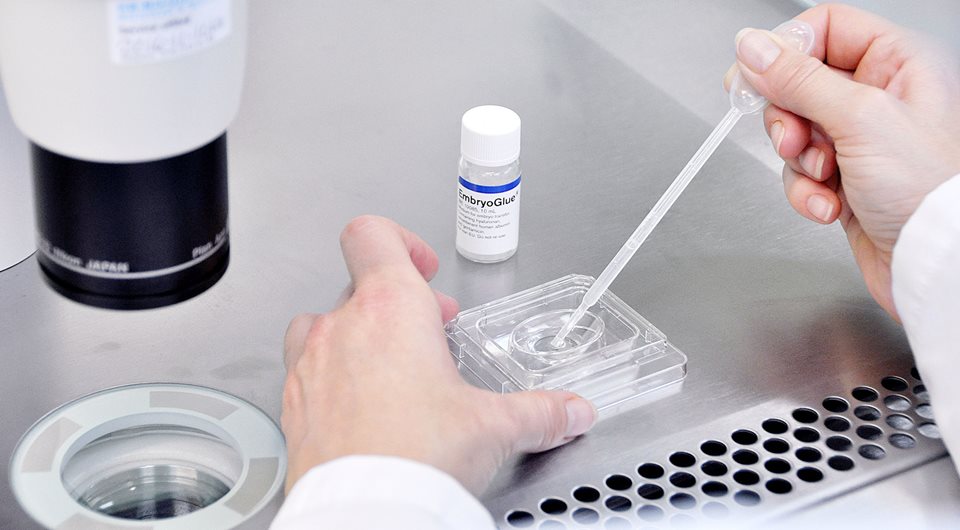
EmbryoGlue is easy to use
It is important to pay attention to the lab and transfer workflow in the clinic when using EmbryoGlue. Being a well-studied transfer medium, EmbryoGlue has more data on transfer optimisation than other products17,25. For transfer protocols, the preparation of dishes, embryo equilibration time, and catheter loading are important factors that can affect the results.
3 things to remember
Follow the instructions for use to ensure stable osmolality, pH and temperature. Below are three important lab procedural steps to follow. Please contact your Vitrolife representative for clincal support.
![]()
Dish volumes
![]()
Embryo equilibration
![]()
Catheter loading
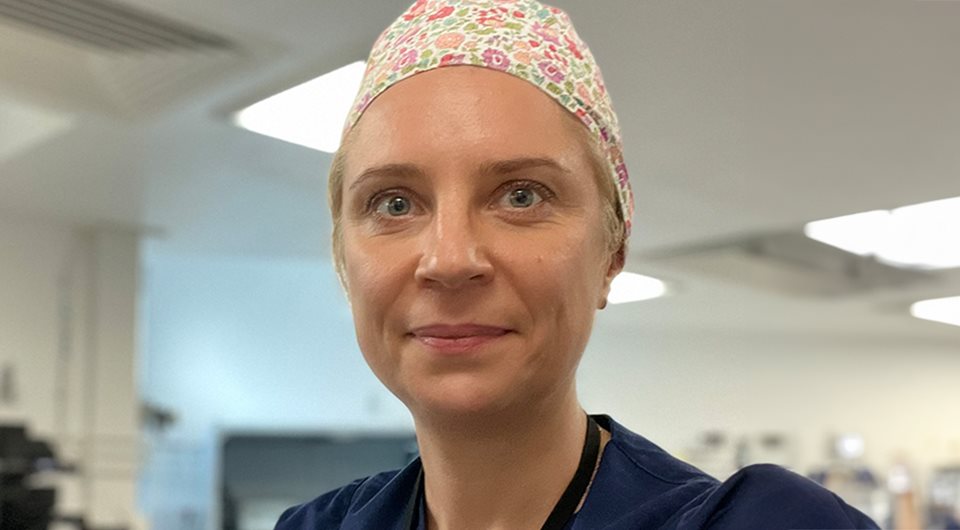
The implementation of EmbryoGlue in our workflow was simple, and all potential reluctancies were easily removed. All technicians and embryologists were enthusiasts, and Vitrolife supported us in the introduction of the media in our lab thanks to their expertise in our field and a very responsive after-sales service, giving us full confidence in their products. We believe that EmbryoGlue provides an optimal environment for embryos just before and during their transfer, and I enjoy seeing a slight increase in pregnancy rates following the introduction of this product in our lab.
- Nathalie Sermondade, MD, PhD, Senior Embryologist and IVF Lab manager of TENON Hospital, Paris, France
Watch a movie of how EmbryoGlue works
Watch a movie of one of our embryologists preparing for embryo transfer with EmbryoGlue.
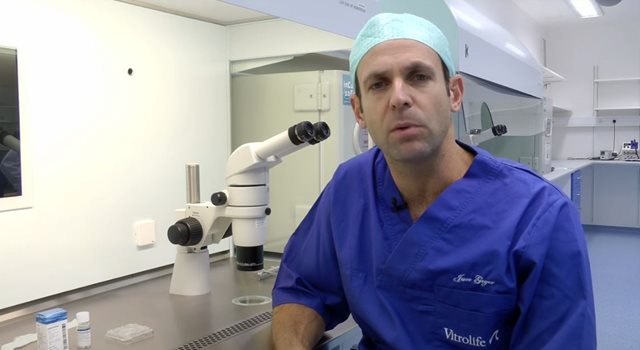
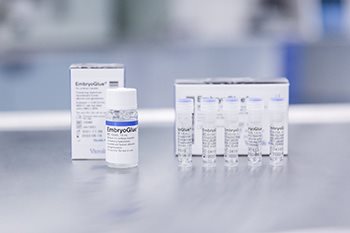
EmbryoGlue - Tips & Tricks
This guide highlights practical tips and tricks when using EmbryoGlue for a successful embryo transfer.
Download now
The benefit of extended exposure to EmbryoGlue when transferring cryopreserved blastocysts
New data supporting treatment benefits with EmbryoGlue is being presented at ASRM. The study is looking at the benefit of extended exposure to EmbryoGlue when transferring cryopreserved blastocysts. Listen to Dr. Oscar Perez, lab director of Dallas Fertility Center, explaining the research and result.

New study evaluating the benefit of EmbryoGlue in PCOS patients
A study by Sayali Kandari, MS PhD, Cellsure Biotech And Research Centre, Mumbai, India, has evaluated the benefit of EmbryoGlue in PCOS patients. The use of EmbryoGlue for time-lapse selected sET in PCOS shows significant increase in implantation and live birth rates with lower miscarriage rates compared with conventional embryo transfer medium.

EmbryoGlue improves the chance of having a baby
See this movie where Laboratory Director Basak Balaban from American Hospital of Istanbul in Turkey explains how using EmbryoGlue for transfer can increase the chance to have a baby.
Optimised implantation with EmbryoGlue® and ERA®
As a global leader in reproductive health and by combining Igenomix’s portfolio of reproductive genetic testing services with Vitrolife’s best-in-class IVF device portfolio, the Vitrolife Group supports clinics and patients across the fertility journey. We offer our customers and patients ground-breaking solutions to create the best conditions for an embryo to implant, with one single goal: to fulfil the dream of having a healthy baby.
Learn more about optimised implantation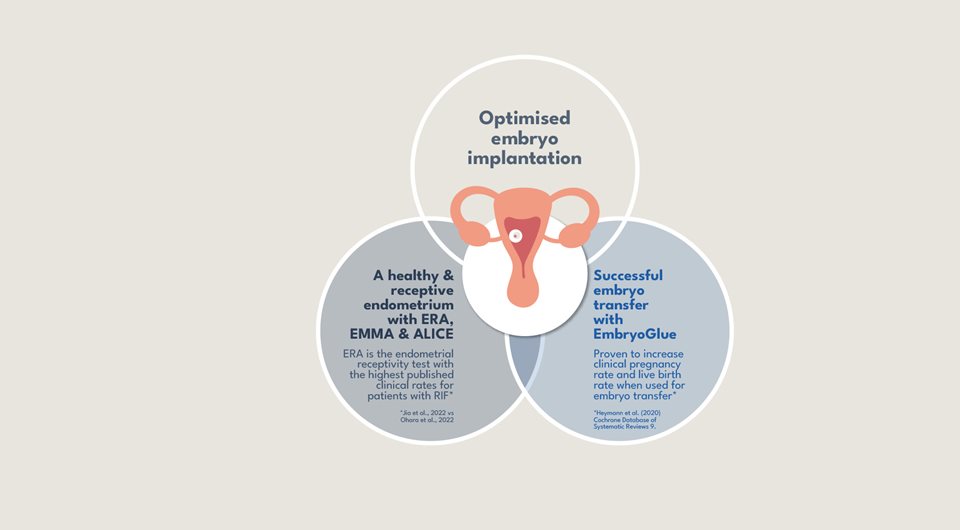
References
1. Heymann et al. (2020) Cochrane Database of Systematic Reviews 9.
2. Tyler et al. (2022) Hum Reprod Update 28.
3. Urman et al. (2008) Fertil Steril (90):3.
4. Lee and Ax. (1984). J Dairy Science 67.
5. Suchanek et al. (1994). Fertil Steril 62.
6. Rodiguez-Martinez et al. (1998). In Gametes: Development and Function, Serono symposia.
7. Kano et al (1998). Biol of Reprod 58.
8. Carson et al. (1987). Dev Biol 120.
9. Zorn et al.( 1995). Cell Mol Biol 41.
10. Turley and Moore. (1984). Biochem Biophys Res Commun 121.
11. Reed and Said (2019) Reprod Biomed Online 39.
12. Stojkovic et al. (2002). Reprod 124.
13. Campbell et al. (1995). Hum Reprod 14 (Suppl 6).
14. Behzad et al. (1994). Biol Reprod 51.
15. Yaegashi et al. (1995). Hum Pathol 26.
16. Stojkovic et al. (2003). Biol Reprod 68.
17. Adeniyi T et al. (2021) Hum Rerpod Open 1.
18. Kandari S (2019) Fertil Steril 112.
19. Balaban et al. (2011). ESHRE oral presentation.
20. Reed (2022) Poster PCRS.
21. Survey about PGS. http://www.ivf-worldwide.com
22. Vitrolife global survey data on file (2016).
23. Hashimoto et al. PP-009. ALPHA 2014.
24. Friedler et al. (2007) Hum Reprod, Vol 22, Issue 9.
25. Perez (2019) Fertil Steril 112.
26. ESHRE Add-ons working group, K Lundin, J G Bentzen, G Bozdag, T Ebner, J Harper, N Le Clef, A Moffett, S Norcross, N P Polyzos, S Rautakallio-Hokkanen, I Sfontouris, K Sermon, N Vermeulen, A Pinborg, Good practice recommendations on add-ons in reproductive medicine, Human Reproduction, 2023;, dead184, https://doi.org/10.1093/humrep/dead184
Support Documents
Documents Language

Package inserts
English
Package insert EmbryoGlue 10085 - Multi-language
Document and Ref: REF 20441, version 12

Package inserts
English
Package insert EmbryoGlue 10168 - Multi-language
Document and Ref: REF 28232, version 03

Short protocols
English
G-Series™ Embryo transfer - EmbryoGlue® 1x10 ml
Document and Ref: REF 19182. Version 03. Date of issue 221216 This short protocol describes how to perform embryo transfer using EmbryoGlue® 1x10 ml.

Short protocols
English
G-Series™ Embryo transfer - EmbryoGlue® 5x1.5 ml
Document and Ref: REF 19187. Version 3. Date of issue 220923. This short protocol describes how to perform embryo transfer using EmbryoGlue® 5x1.5 ml.

Safety data sheets (SDS)
English
SDS EmbryoGlue
Document and Ref: Date Revised : 01/08/2025. Revision No : 8. Safety data sheet for EmbryoGlue

SSCP
English
SSCP EmbryoGlue
Document and Ref: REP-2379. VErsion 8.0. 2025/04/10

Scientific summaries
English
EmbryoGlue improves pregnancy and implantation rates. Results from a meta-analysis on almost 10,000 embryo transfers
Document and Ref: A meta-analysis of Japanese studies, including almost 10,000 cycles shows that EmbryoGlue improves implantation resulting in increased pregnancy rates confirming findings from the Cochrane reports.
Do you have a question about this product?
Contact us
Find your local Vitrolife representative
Contact usMaximise success every step of the way
We provide what you need to secure improved results throughout the IVF journey.
